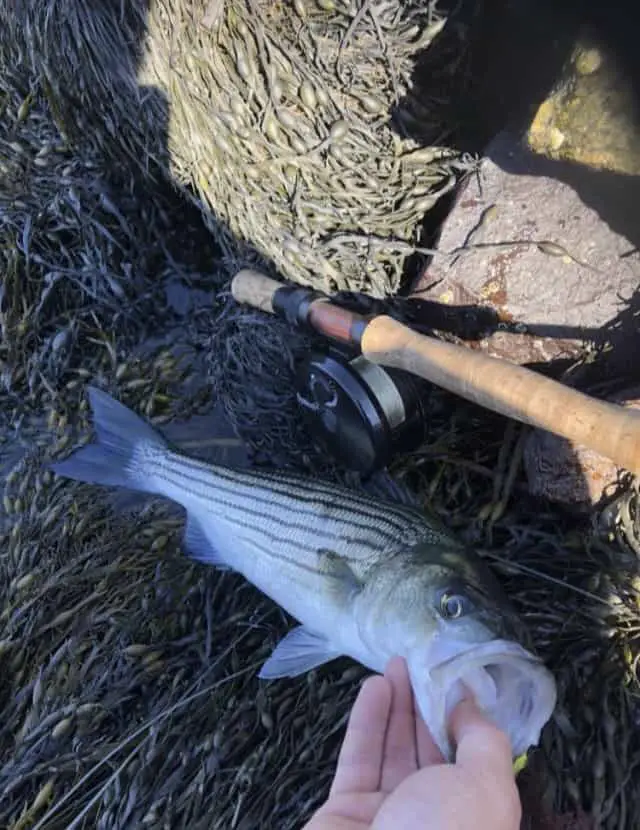There are many different methods of fishing or just ways to fish. There is baitfishing, spooning or jigging, and trolling and also drift fishing. Is there a difference between drifting for striped bass and trolling? To a point, yes. You can use your boat to help you drift fish, or you can anchor your boat to drift fish. You can also stand on the shore and drift fish, down the current of the river.

Drifting is defined as; to be carried along by currents, air, or water and to proceed or move unhurriedily and smoothly.
Trolling on the other hand is defined as; to fish for by trailing a baited line from behind a slow moving boat.
Therefore; trolling vs. drifting equals; when you are trolling you control and can manipulate the presentation of the bait. You are also moving faster, with the bait trailing behind the boat, normally using an umbrella rig. If you are drifting, your line is straight down the side of the boat, with the boat guiding your line through the current. With drifting, the environment is, more or less, in control because it depends on the speed of the current and the wind. Drifting bait through a current, to catch a striped bass, is a productive method and quite easy to do. But, just because it is easy to do, doesn’t mean you are always going to catch the striper. You need to know where they are feeding at, and adjust your equipment and your cast depending on how fast the current is.
Got a rod and reel combo for stripers? Heres an Uglystick!
Many fisherman use salted herring to drift for striped bass. The herring is oily, so it leaves a scent trail as it drifts through the water. Frozen bait will work but of course, live bait is better. Sometimes the weight of the bait is enough to carry the hook down to the feeding stripers, and sometimes you will need to add a little weight to your line. You want to cast slightly upstream, leaving the bail open and allowing the bait to drift down through the current. You don’t want your bait dragging the bottom, but you also do not want it right on the surface.
The best places to drift for striped bass is on a shoreline or dock. You can also drift from an anchored boat. This will allow you better access to rocky points and piers where stripers hang out. Your goal is to use as little weight as possible, so your bait will drift freely down the current. Try to match the weight of the bait and tackle to the speed of the current and the depth of the water. The more life like the bait is, the better it will look like food to the striper as it cruises down through the current.
Some other natural baits that will leave a scent trail to entice the striped bass; squid, clams, and sand worms. A basic drift rig setup consists of; a three way swivel, 2-3 foot leader, bait sinker, and your live bait on a 2/0-3/0 wide gap hook. A shallow water rig is almost the same; rubber core sinker, barrell swivel, 3 foot leader, and 1/0-3/0 baitholder dressed with the live bait of your choice. If you have to drift with a weight you want to keep the bait near the bottom, but not dragging the bottom. You can also suspend the bait beneath a popping cork or bobber.
If you are out on a boat, doing a little drift fishing for striped bass, you want to move upwind of other boats as you don’t want to block the rhythm of boat. Determine your direction, where the current is flowing the best, and go slightly above that area. As your boat drifts with the current or the wind, it will help you in fishing right over a striper habitat that may be swimming through the current in search of lunch. You can also anchor your boat, instead of letting it drift with the current. This keeps youi in one spot, out of the path of other boats, but being upstream your line will still drift down the current into the striped bass habitat.
Th perfect cast is approximately 10-15 degrees up stream from where you are standing, so that the lure is just above the bottom when it reaches straight out in front of you. Follow the drift all the way through, and then reel in; not quickly but not too slowly either. Once you master the art of drift fishing, you can fish on ponds, lakes, rivers, and in streams at any time of the year for most species of fish. Of course, the striped bass are a special character, and there are better times than others to catch a striper. So you need to do your research on the area that you will be going to. Weather, water conditions, time of year, and tide times. Find the best current locations, and ask around. Where do the striper normally hang out and feed?
Anglers say that live bait is best for drift fishing, but you can also use a diving plug or a soft plastic lure to catch a striper while drifting. They will dig in and maintain a good wobble in the current, making them look life like and attracting the stripers. It is suggested, by experienced drifters, that you use a 12-foot surf rod, 20lb test line, and a spinning reel to catch the unpredictible striped bass. If you are going to use a large spoon lure, you will want to attach a ball-bearing swivel to avoid the line twisting. Strikes from a striper are difficult to detect if you are fishing in a fast current. There are times when you are unsure if it is an actual snag of the hook, or the strength of the current. The striped bass will allow the lure to into its mouth, as directed by the current.
As an opportunistic fish, the striped bass can be caught with just about any bait. If you choose to use a lure, there are certain factors to consider. If you are fishing in a new area you can ask local bait and tackle shops for tips, and what bait that they recommend for drift fishing for the striper in the area. Some lures that work best are the ones that resemble the forage in the area and can be made out of metal, plastic, resins, wood or rubber. But remember, for drifting it is best to use the plastics (soft) or diving plugs.
On the Sacramento River, one of the renowned fishing guides states that drifting with live bait, during the day is going to be more effective than the other methods. Your fish may not be quite as big with drifting, as they are with baitfishing or cast and retrieve, but you will catch fish. 6 1/2 foot to 8 foot fishing pole is what he uses with a medium action (bends in the middle), 30-50 pound braided line (but you could get away with 20 pound), and a big casting reel. 18-28 inch striped bass are the best ones to keep and eat. The bigger the fish, the tougher the meat is going to be.
Hey FISHMONGER – make sure to check out my FISHING RESOURCES page.
As with any other types of fishing, a lot of your success is going to depend on the weather, water conditions, time of day, and bait used. Drift fishing for striper is a critter all its own, kind of like trolling. It is going to take patience. Letting your line follow the current all the way down, reeling in the line, and casting again. You have to have patience and you need to locate the most prime spot for drift fishing in the area. Trolling is a little easier, but still requires patience, because you don’t always catch striper immediately. With drifting or trolling, it could take a few hours to catch a striped bass, depending on all the factors involved.
If you are going to drift deep for striped bass, the mojo rig will work, but you will have to keep it very close to the bottom (but NOT touching the bottom). As with trolling, you can also use a deep water rig and do your drifting around sandy beaches. Of course, things are going to vary slightly by area. Drifting for striped bass will be a little bit of trial and error at first, unless you really know the area and the striper habitat extremely well. A lot of anglers use a simple bass rig for drifting for striper. You don’t have to have anything fancy or super special. Just a different set-up than other methods.
If you are going to drift from a boat, it may not be a bad idea to invest in a fish finder. Fish finders provide you with a lot of information about where the fish are, the water temp and many other things. Most avid anglers, who are out to make sure they catch something everytime they are in their boat, have a fish finder of some kind. Some are simple and inexpensive and some are top of the line and expensive. Research the different brands, features, and costs to make sure you get something that is within your means but will do the job that you want it to.
On Cape Cod you have a few areas with fast currents, perfect for drift fishing. Large live bait, such as eels, mackerel, or bunker will work perfectly for drifting for striper around the Cape Cod Canal.
Drifting for striped bass, as stated earlier, is similar to trolling. You can either anchor the boat or you can allow the boat to drift with the current. Every angler has their preferred method, favorite spot and special lure or combination of. Wheather you are in New York, South Carolina, Lake Texoma, or another popular striped bass area; talk to local anglers, bait & tackle shops, restaurant, and resort employees/owners. Most of them have lived in the area for a number of years and can give you some good tips, great fishing spots and suggested lures.
If you are new to the area, or are on vacation; hire a fishing guide. They can teach you anything and everything there is to know about drift fishing for striped bass and they are willing to teach you. That is their job. They know all of the perfect areas to drift fish, they know the perfect live bait for each specific area, they know the time of day that is best to drift fish for striper and anything else you need or want to know. You are almost always guaranteed to catch at least one fish, if you hire a guide to take you out on the waters.
Study, study, and research before you go out drifting. The more you know the better your chances of snagging a striper. You can also find a river with a steady current, study that river to see if striped bass are ever in the area and when. Take your pole, your bait, and a notebook. Jot down notes on the weather, current speed, lure, depth of lure and anything else that may help you drift fish in that area again. There are challenges to every method of fishing and there are always ways to learn the tricks to catching a striped bass.
So; get that pole, your live eels, your notebook and go out and try your hand at drift fishing for the elusive striped bass. Even if you catch something besides a striped bass, you succeeded.


